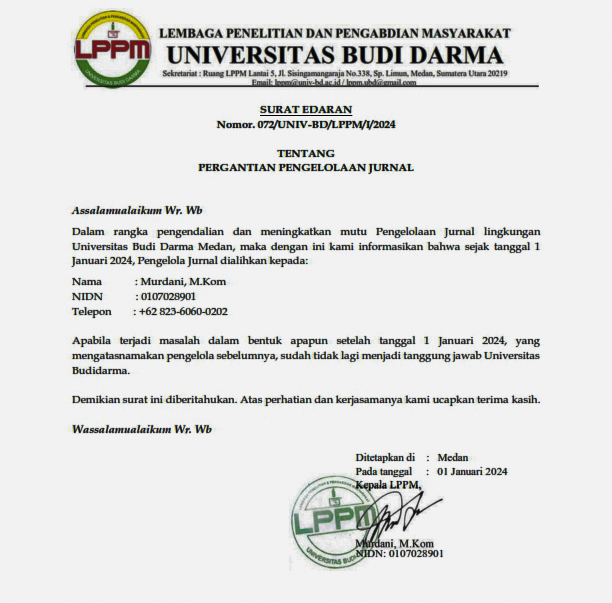Rancang Bangun Prototype Robot Pengantar Barang Cargo Berbasis Arduino Mega Dengan IOT
DOI:
https://doi.org/10.30865/json.v1i3.2186Keywords:
Arduino Mega, Cargo, Android Studio, Line Follower, Internet Of ThingsAbstract
Cargo is the goods transported by ship, aircraft or other types of transportation. Cargo is divided into three types of transportation, namely, air, land and sea. Cargo service is a special service for transporting goods using aircraft. This service can be organized by a regular airline that serves passengers, but can also be carried out by a specialized airline freight company. With the development of industrial automation technology, robots are needed to help meet their needs quickly. With this developed robotics technology to help alleviate human work in the future. Goods delivery robot is a robot created to help work in delivering goods to aircraft cargo. This robot can stuff automatically. This goods transfer robot uses the Internet of Things method that is already connected to a smartphone remote control based on an android application. Writing program code using Arduino IDE 1.8.9 and using Android as a robot control. This robot uses 4 channel line tracker sensors, 2 DC motors and motor drivers as controllers, Arduino uno as the brain in this robot system. The results of this study produce a prototype robot that can deliver goods into aircraft cargo in airports.
References
Kadir, Abdul, (2018), Dasar Pemograman Robot Menggunakan Arduino, Yogyakarta : Penerbit Andi.
Purti, Andini dan Maspiyanti, Febri (2017), Robot Line Follower Pengantar Surat Menggunakan Metode Fuzzy Logic Studi Kasus Fakultas Teknik Universitas Pancasila, Jakarta : Jurnal Teknologi Terpadu Vol. 3, No.1.
Falani, Achmad Z dan Budi, Setyawan, (2015), Robot Line Follower Berbasis Mikrokontroler Atmega 16 dengan Menampilkan Status Gerak Pada LCD, Surabaya : e-Jurnal NARADROID, Vol.1 No. 1.
Adriansyah, Andi dan Hidayatama, Oka, (2013), Rancang Bangung Prototipe Elevator Menggunakan Microcontroller Arduino AT Mega 328P. Jakarta :Jurnal Teknologi Elektro, Vol.4 No.3.
Yuliza dan Kholifah, Umi N, (2015), Robot Pembersih Lantai Berbasis Arduino Uno Dengan Sensor Ultrasonik, Jakarta Barat : Jurnal Teknologi Elektro, Vol.6 No.3.
Lestari, Novi, (2017), Rancang Bangun Pintu Otomatis Menggunakan Arduino Uno dan PIR (Passive Infra Red) Sensor di SMP Negeri Simpang Semambang, Lubuklinggau : JUSIKOM, Vol 2 No.2.
Aryani, Diah, et.al, (2013), Sistem Pengendalian Secara Otomatis Pada Robot Line Follower Menggunakan Mikrokontroler AT89S51, Tangerang : CSRID Journal, Vol.5 No.1.
Birdayansyah, Radi, et al,(2015), Pengendalian Kecepatan Motor DC Menggunakan Perintah Suara Berbasis Mikrokontroler Arduino, Bandar Lampung : Jurnal Rekayasa dan Teknologi Elektro Volume 9, No.2.
Dwiprasetiabudhi, Samuel F, et.al, (2015), Perancangan dan Realisasi Sistem Automatic Guided Vehicle (AGV) menggunakan Algoritma Dijkstra dan Fuzzy Logic, Bandung : e-Proceeding of Engineering : Vol.2,No.2.
Wahyudi, Hebi J, et.al, (2015), Perancangan dan Realisasi Robot Line Follower untuk Pengangkut Sampah Otomatis, Bandung : e – Proceeding of Applied Science : Vol 1, No.3.
Downloads
Published
How to Cite
Issue
Section
License

This work is licensed under a Creative Commons Attribution 4.0 International License
Authors who publish with this journal agree to the following terms:
- Authors retain copyright and grant the journal right of first publication with the work simultaneously licensed under Creative Commons Attribution 4.0 International License that allows others to share the work with an acknowledgment of the work's authorship and initial publication in this journal.
- Authors are able to enter into separate, additional contractual arrangements for the non-exclusive distribution of the journal's published version of the work (e.g., post it to an institutional repository or publish it in a book), with an acknowledgment of its initial publication in this journal.
- Authors are permitted and encouraged to post their work online (e.g., in institutional repositories or on their website) prior to and during the submission process, as it can lead to productive exchanges, as well as earlier and greater citation of published work (Refer to The Effect of Open Access).





